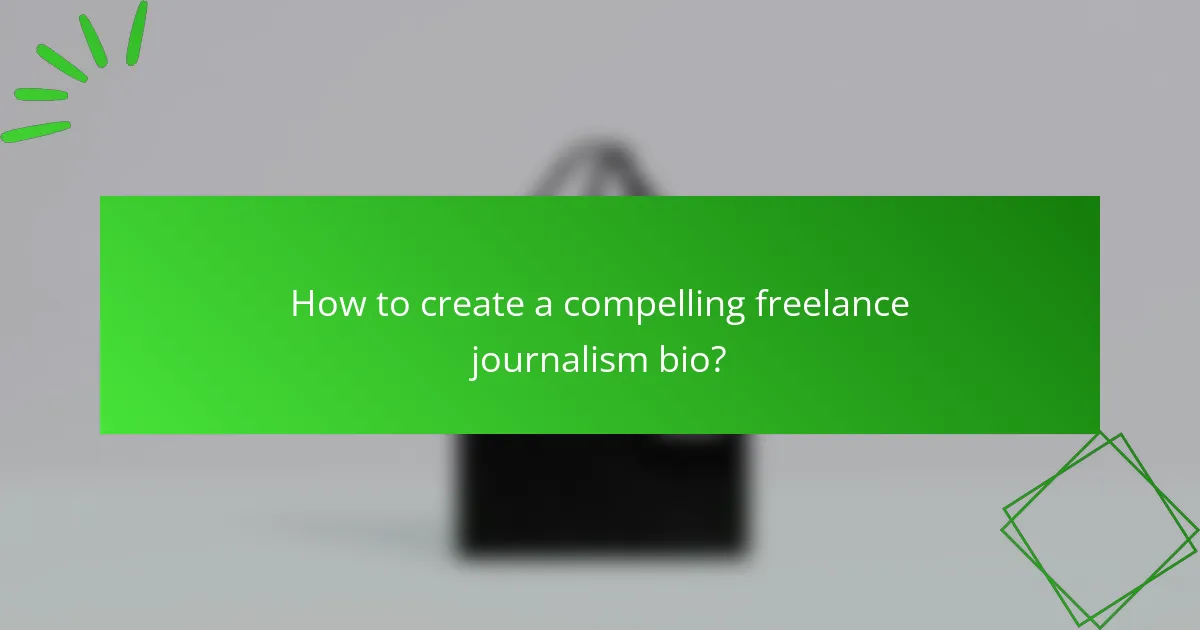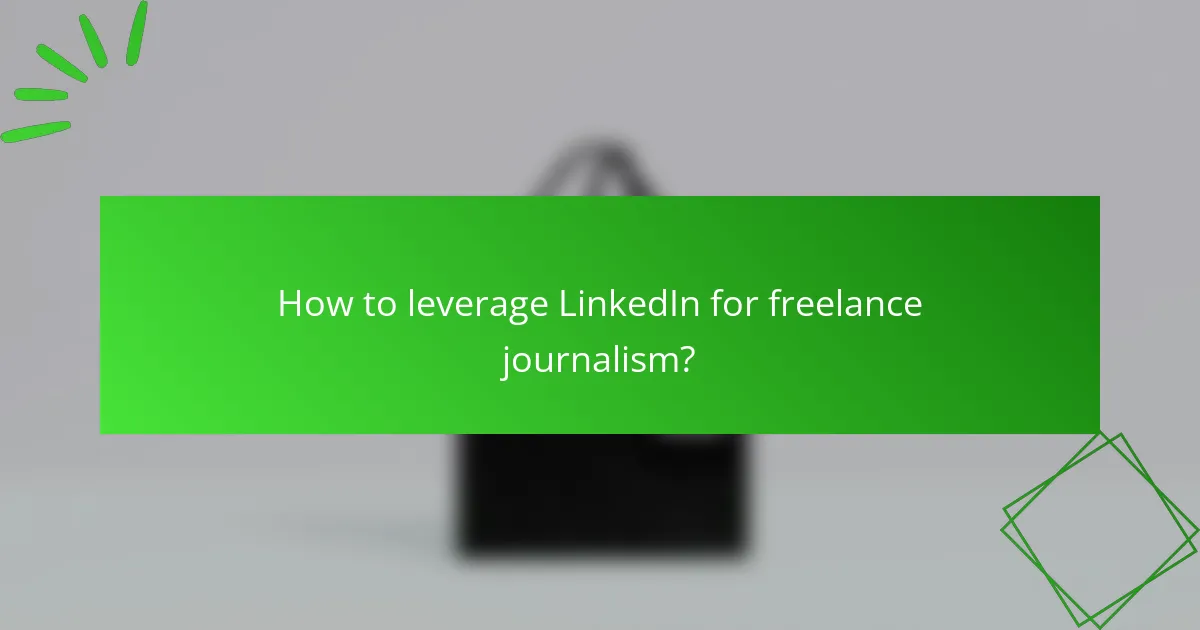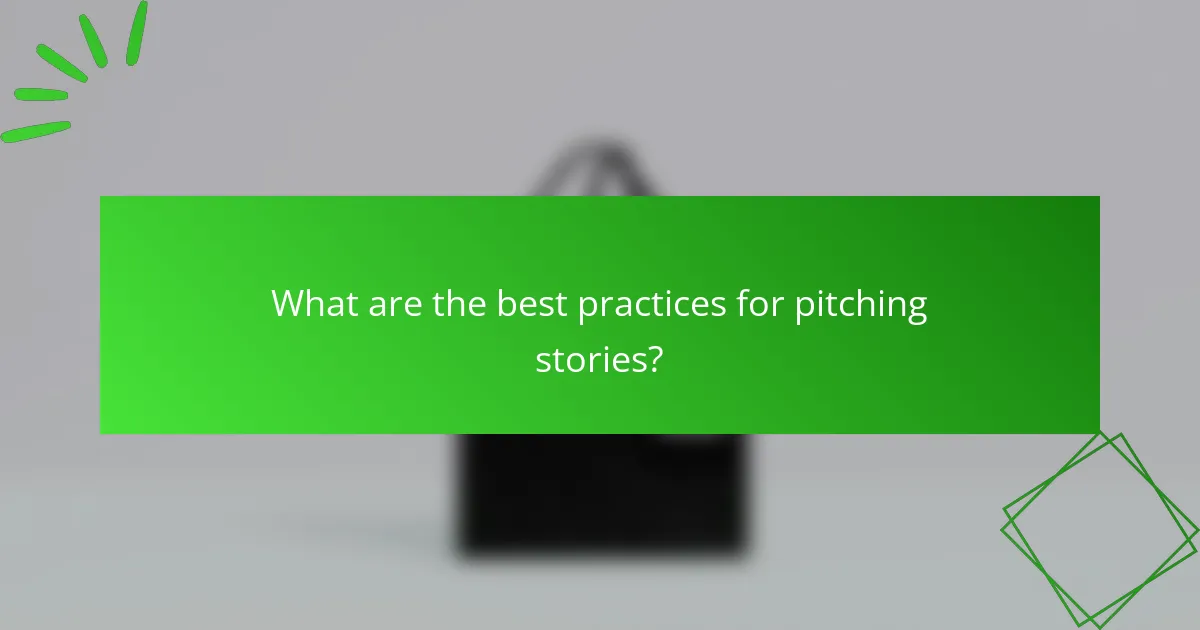In the competitive world of freelance journalism, a compelling bio is essential for showcasing your identity, expertise, and unique perspective. By effectively establishing your personal brand and professional identity, you can attract clients and build a loyal readership that resonates with your unique voice and journalistic focus.

How to create a compelling freelance journalism bio?
A compelling freelance journalism bio should succinctly convey your identity, expertise, and unique perspective. It serves as a personal branding tool that attracts potential clients and readers by showcasing what sets you apart in the industry.
Highlight key achievements
Begin your bio by listing significant accomplishments that demonstrate your credibility as a freelance journalist. This could include notable publications, awards, or impactful stories you’ve covered. Aim to quantify your achievements where possible, such as mentioning the readership size of a publication or the number of articles published in a year.
For example, stating that you contributed to a major outlet like The New York Times or won a regional journalism award can instantly elevate your profile. Keep this section concise but impactful, focusing on achievements that resonate with your target audience.
Showcase unique voice
Your unique voice is what distinguishes you from other journalists. Use your bio to convey your writing style and perspective, whether it’s analytical, narrative, or conversational. This helps potential clients understand what to expect from your work.
Consider including a brief example of your writing style or a quote that encapsulates your approach to journalism. This not only showcases your personality but also invites readers to connect with your work on a deeper level.
Include relevant experience
Detail your relevant experience in journalism, including internships, freelance gigs, or full-time positions. Highlight specific roles that have equipped you with skills pertinent to your niche, such as investigative reporting or multimedia storytelling.
Be sure to mention any specialized training or education that enhances your qualifications, such as a degree in journalism or workshops in digital media. This establishes your expertise and builds trust with potential clients.
Utilize storytelling techniques
Incorporate storytelling techniques into your bio to engage readers emotionally. Start with a hook that draws them in, such as a personal anecdote or a pivotal moment in your career. This makes your bio more relatable and memorable.
Use vivid language and descriptive details to paint a picture of your journey as a journalist. This not only highlights your passion for the field but also invites readers to see the world through your eyes, making them more likely to follow your work.

What are effective personal branding strategies for freelance journalists?
Effective personal branding strategies for freelance journalists focus on establishing a unique identity and consistent visibility in the marketplace. By leveraging online platforms and creating a professional image, journalists can attract clients and build a loyal audience.
Develop a consistent online presence
Creating a consistent online presence is crucial for freelance journalists to establish credibility and recognition. This involves regularly updating profiles on platforms like LinkedIn, Twitter, and relevant journalism sites, ensuring that your bio, portfolio, and contact information are uniform across all channels.
Consider using a specific color scheme, logo, or tagline that represents your brand. This visual consistency helps audiences easily identify your work and reinforces your professional identity.
Engage on social media platforms
Active engagement on social media platforms is essential for building relationships and expanding your reach. Freelance journalists should share their articles, comment on industry trends, and interact with followers to foster a community around their work.
Utilize platforms like Twitter for real-time news sharing and LinkedIn for professional networking. Regularly posting insights or participating in discussions can enhance your visibility and establish you as a thought leader in your niche.
Create a professional website
A professional website serves as a central hub for your portfolio, bio, and contact information. It should showcase your best work, highlight your expertise, and include a blog or news section to keep content fresh and engaging.
Ensure your website is mobile-friendly and optimized for search engines to attract organic traffic. Including testimonials and links to published work can further enhance your credibility and appeal to potential clients.

How to establish a professional identity as a freelance journalist?
Establishing a professional identity as a freelance journalist involves defining your unique voice and positioning yourself effectively in the market. This identity should resonate with your target audience and reflect your expertise in specific areas of journalism.
Define niche and target audience
Identifying your niche is crucial for standing out in the competitive field of freelance journalism. Consider focusing on specific topics such as technology, health, or social issues, which can help you attract a dedicated readership.
Your target audience should align with your niche. For instance, if you specialize in environmental journalism, your audience may include eco-conscious readers, policymakers, and organizations focused on sustainability.
Network with industry professionals
Building a network of industry professionals is essential for freelance journalists. Attend journalism conferences, workshops, and local meetups to connect with editors, fellow writers, and potential collaborators.
Utilize social media platforms like LinkedIn and Twitter to engage with industry leaders and share your work. Regularly participating in discussions can enhance your visibility and credibility within the journalism community.
Seek mentorship opportunities
Finding a mentor can significantly accelerate your growth as a freelance journalist. Look for experienced journalists who can provide guidance, feedback, and insights into the industry.
Consider reaching out to professionals through networking events or online platforms. A mentor can help you navigate challenges, refine your skills, and expand your professional connections.

What are the key elements of a freelance journalist portfolio?
A freelance journalist portfolio should effectively showcase your writing skills, published work, and client feedback. These elements help potential clients understand your expertise and style, making it easier for them to decide to hire you.
Include diverse writing samples
To attract a variety of clients, your portfolio should feature diverse writing samples that demonstrate your versatility. Include articles from different genres, such as news reports, feature stories, and opinion pieces, to showcase your range.
Consider including samples that reflect various formats, such as online articles, print pieces, and multimedia content. This variety not only highlights your adaptability but also appeals to clients looking for specific styles or approaches.
Showcase published work
Highlighting your published work is crucial for establishing credibility as a freelance journalist. Include links or PDFs of articles that have appeared in reputable publications, as this demonstrates your ability to meet industry standards.
Organize your published pieces by type or topic to make it easy for potential clients to find relevant examples. If possible, include a brief description of each piece, outlining your role and the publication’s audience.
Highlight client testimonials
Client testimonials can significantly enhance your portfolio by providing social proof of your skills and professionalism. Reach out to past clients for feedback and include their quotes in your portfolio to build trust with potential clients.
When showcasing testimonials, focus on specific aspects of your work that clients appreciated, such as meeting deadlines or producing high-quality content. This targeted feedback can help prospective clients understand the value you bring to their projects.

How to leverage LinkedIn for freelance journalism?
Leveraging LinkedIn for freelance journalism involves optimizing your profile, engaging with relevant communities, and sharing valuable content. This platform can enhance your professional visibility and connect you with potential clients and collaborators.
Optimize profile for visibility
To optimize your LinkedIn profile, ensure that your headline clearly states your role as a freelance journalist. Use keywords related to your niche, such as “investigative journalist” or “content writer,” to improve searchability.
Include a professional photo and a compelling summary that highlights your skills and experiences. Regularly update your profile with new projects, articles, and accomplishments to keep it fresh and engaging.
Join relevant groups and discussions
Joining LinkedIn groups related to journalism can significantly expand your network. Participate in discussions, share your insights, and ask questions to establish your presence in the community.
Look for groups focused on your specific areas of interest, such as digital journalism or freelance writing. Engaging actively can lead to valuable connections and potential job opportunities.
Share industry insights and articles
Regularly sharing articles and insights related to journalism can position you as a thought leader in your field. Post your own articles or share relevant content from trusted sources to engage your audience.
Consider writing posts that discuss trends, challenges, or tips in freelance journalism. This not only showcases your expertise but also invites interaction from your network, enhancing your visibility.

What are the best practices for pitching stories?
The best practices for pitching stories involve crafting a clear, concise proposal that highlights the unique angle of your story while aligning with the publication’s audience and style. A successful pitch should capture the editor’s attention quickly and provide all necessary details to facilitate decision-making.
Understand the publication
Before pitching, research the publication thoroughly. Familiarize yourself with its tone, style, and the types of stories it typically publishes. This knowledge allows you to tailor your pitch to fit the publication’s needs, increasing your chances of acceptance.
Look for recent articles to identify gaps or trends that your story could fill. Understanding the audience’s interests will help you present your idea in a way that resonates with both the editors and readers.
Craft a compelling subject line
Your subject line is the first impression of your pitch. Make it engaging and informative, summarizing your story’s essence in a few words. A strong subject line can significantly increase the likelihood of your email being opened.
Consider using action verbs or posing a question to pique interest. For example, instead of “Story Idea: Local Festival,” try “How the Local Festival Revives Community Spirit.” This approach makes your pitch stand out in a crowded inbox.
Be concise and clear
Keep your pitch brief, ideally under 200 words. Clearly state your story idea, why it matters, and how it fits the publication. Avoid jargon and unnecessary details; focus on the core elements that will grab the editor’s attention.
Use bullet points to break down key aspects of your story, such as the main angle, potential sources, and any relevant statistics. This format makes it easier for editors to digest your proposal quickly.
Include your credentials
Highlight your qualifications and relevant experience to establish credibility. Briefly mention previous publications or relevant expertise that supports your ability to cover the proposed story effectively.
For instance, if you have written about similar topics or have a background in the subject matter, include that information to reinforce your authority. This can help editors feel more confident in your ability to deliver a quality piece.
Follow up appropriately
If you haven’t received a response within a week or two, consider sending a polite follow-up email. Express your continued interest in the story and inquire if the editor needs any additional information.
However, avoid being overly persistent. If you receive a rejection, take it gracefully and consider asking for feedback. This can provide valuable insights for future pitches.

